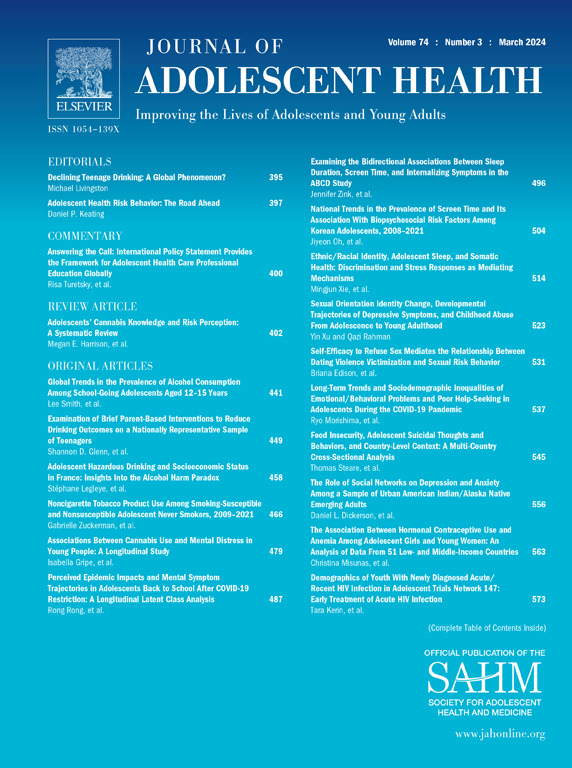按童年不良经历维度划分,积极的童年经历与青少年和即将成年女性酗酒的相关性。
IF 5.5
2区 医学
Q1 PEDIATRICS
引用次数: 0
摘要
目的:童年时期的多种不良经历(ACEs)与女性青少年和新成人酗酒有关。有理论认为,保护性和补偿性经历(PACE)可以抵消童年时期累积的 ACE 对健康和行为造成的影响。本研究探讨了在报告两个 ACE 维度(家庭功能障碍和情感虐待/忽视)水平高低的女性青少年和新成人中,保护性经历与随后一个月内饮酒和酗酒频率之间的关系:43 名年龄在 15-24 岁之间、表示在过去两周内至少有过一次酗酒经历的女性填写了六项 ACEs 量表、PACEs 量表,并在基线时填写了人口统计数据。在接下来的一个月中,每周的预约都会采用时间轴跟踪法对酒精消耗量进行前瞻性测量:结果:有两个 PACEs 因素具有显著的直接相关性,其中无条件爱的来源与较少饮酒有关(β = -0.437,95% 置信区间 [CI] -0.744,-0.131,exp(β) = 0.65,p = .在家庭功能严重失调的情况下,β = 0.437,95% 置信区间 [CI]-0.744,-0.131,exp(β) = 0.65,p = .005;在情感虐待/忽视严重的情况下,β = -1.373 ,95% 置信区间 [CI] -2.283,-0.464,exp(β) = 0.25,p = .003)预示着较少的酗酒情况。无论是否暴露于 ACE 维度,在所有 ACE 维度中,非体育社会团体成员身份与当月更频繁饮酒相关(β = 0.11-0.74, 95% CI -0.11, 0.74, exp(β) = 1.37 - 1.62, p ≤ .002);在家庭功能失调程度较低的人群中,有一个值得信赖的成年人可以提供帮助和建议与饮酒频率增加 5.7 倍相关(β = 1.74,95% CI 0.83,2.65,exp(β) = 5.70,p < .001):讨论:很少有 PACE 项目与直接减少酗酒结果相关。事实上,与童年逆境经历无关,非体育群体成员在酗酒频率方面的风险持续增加。未来的研究应确定哪些保护性因素最有可能抵消ACE维度的酒精使用。本文章由计算机程序翻译,如有差异,请以英文原文为准。
Positive Childhood Experiences are Associated With Alcohol Use in Adolescent and Emerging Adult Females by Adverse Childhood Experiences Dimension
Purpose
Experiencing multiple adverse childhood experiences (ACEs) is associated with alcohol use in female adolescents and emerging adults. Protective and compensatory experiences (PACEs) have been theorized to off-set the health and behavioral consequences from the accumulation of ACEs throughout childhood. This study examines the association between protective experiences and subsequent alcohol and binge alcohol use frequency over one month among female adolescent and emerging adults reporting high and low levels of two ACE dimensions (household dysfunction and emotional abuse/neglect).
Methods
One hundred 43 females between the ages of 15–24 who indicated at least one binge episode in the past two weeks completed the six-item ACEs scale, the PACEs scale, and demographics at baseline. Alcohol consumption was measured prospectively over the next month during weekly appointments using the timeline follow back approach.
Results
Two PACEs factors had significant direct associations, a source of unconditional love was associated with less frequent alcohol use (β = −0.437, 95% confidence interval [CI] -0.744, −0.131, exp(β) = 0.65, p = .005) in the context of high household dysfunction; and having a trusted adult to count on for help and advice (β = −1.373, 95% CI -2.283, −0.464, exp(β) = 0.25, p = .003) predicted fewer binge occasions in the context of high emotional abuse/neglect. Regardless of ACE dimension exposure, nonsport social group membership was associated more frequent alcohol use over the month across all ACE dimensions (β = 0.11-0.74, 95% CI -0.11, 0.74, exp(β) = 1.37 – 1.62, p ≤ .002); and having a trusted adult to count on for help and advice was associated with a 5.7 times more frequent of alcohol use among those with low household dysfunction (β = 1.74, 95% CI 0.83, 2.65, exp(β) = 5.70, p < .001).
Discussion
Few PACE items are associated with direct reductions in alcohol outcomes. Indeed, there is consistently heightened risk associated with nonsport group membership for alcohol use frequency, regardless of experiences of childhood adversity. Future research should identify which protective factors have the most potential to off-set alcohol use by ACE dimension.
求助全文
通过发布文献求助,成功后即可免费获取论文全文。
去求助
来源期刊

Journal of Adolescent Health
医学-公共卫生、环境卫生与职业卫生
CiteScore
10.40
自引率
3.90%
发文量
526
审稿时长
46 days
期刊介绍:
The Journal of Adolescent Health is a scientific publication dedicated to enhancing the health and well-being of adolescents and young adults. Our Journal covers a broad range of research topics, spanning from the basic biological and behavioral sciences to public health and policy. We welcome a variety of contributions, including original research papers, concise reports, literature reviews, clinical case reports, opinion pieces, and letters to the editor. We encourage professionals from diverse disciplines such as Anthropology, Education, Ethics, Global Health, Health Services Research, Law, Medicine, Mental and Behavioral Health, Nursing, Nutrition, Psychology, Public Health and Policy, Social Work, Sociology, and Youth Development to share their expertise and contribute to our mission of promoting adolescent health. Moreover, we value the voices of young individuals, family and community members, and healthcare professionals, and encourage them to submit poetry, personal narratives, images, and other creative works that provide unique insights into the experiences of adolescents and young adults. By combining scientific peer-reviewed research with creative expressions, our Journal aims to create a comprehensive understanding of the challenges and opportunities in adolescent and young adult health.
 求助内容:
求助内容: 应助结果提醒方式:
应助结果提醒方式:


